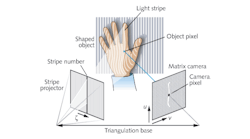2D gesture recognition technology works in natural light
Existing hand gesture recognition (HGR) technologies require infrared or 3D cameras and will only work in artificial light, limiting them to the gaming industry and smart TVs. But a new technology from University of Warwick (Coventry, England) researchers works in both natural and artificial light, can recognize both gesture and posture, is more economical and practical, and opens up the possibilities of HGR being used in the automotive, health, and consumer electronics sectors on ordinary mobile phones and tablet computers.
Related Article
Software developed by researchers at the University of Warwick allows HGR to work using the 2D cameras in everyday consumer electronic products, such as mobile phones and tablet computers, in uncontrolled environments with both natural and artificial light.
Co-inventor Yi Yao argues that in the medical field "surgeons, who currently cannot use traditional computers in operating rooms, could search hands-free for data or switch between appliances and similarly, whilst cooking in the kitchen, we could instruct our mobile phones to take a call on speaker or switch to music or video."
Discussing the technological advance made by the technology Professor Chang-Tsun Li from the Department of Computer Science and its co-inventor said that the "research is a highly significant breakthrough when compared to the existing technology that can only function in isolated and non-real life environments. Along with the ability to continue working when other people are moving in the background, adapt to changing lighting conditions and to cope when the hand temporarily moves out of sight, our research not only goes beyond existing HGR technology, but it also makes it practical and easily available for consumers," added Li.
Analysts at Markets and Markets predict that the global gesture recognition market is due to grow from $0.3bn last year to an $11.03bn industry by the end of 2020. Shum Prakash, business development manager at Warwick Ventures said, "For the gesture recognition sector to grow, it needs new, innovative products that address the problems with existing technology and can be easily applied in people's day-to-day lives. By being able to be used on the devices we already own, this new technology solves both of these problems and could lead to HGR technology becoming an integral part of the automotive, health and consumer electronic sectors."
A patent application has been filed to PCT (International) Stage and the scientists, with Warwick Ventures, being keen to work with commercial partners to bring this technology to market.
SOURCE: University of Warwick; http://www2.warwick.ac.uk/newsandevents/pressreleases/first_real-time_natural/
About the Author

Gail Overton
Senior Editor (2004-2020)
Gail has more than 30 years of engineering, marketing, product management, and editorial experience in the photonics and optical communications industry. Before joining the staff at Laser Focus World in 2004, she held many product management and product marketing roles in the fiber-optics industry, most notably at Hughes (El Segundo, CA), GTE Labs (Waltham, MA), Corning (Corning, NY), Photon Kinetics (Beaverton, OR), and Newport Corporation (Irvine, CA). During her marketing career, Gail published articles in WDM Solutions and Sensors magazine and traveled internationally to conduct product and sales training. Gail received her BS degree in physics, with an emphasis in optics, from San Diego State University in San Diego, CA in May 1986.
